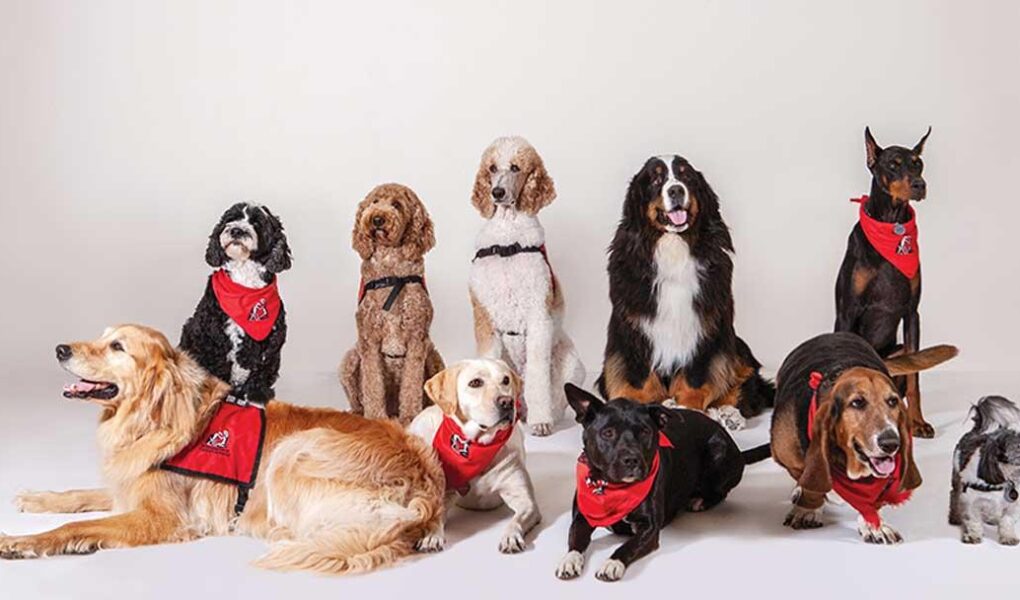In a world where connection often feels fleeting, the gentle presence of a therapy dog can bridge the gap between isolation and companionship. These remarkable canines undergo specialized training to become more than just pets; they become vital companions, offering comfort and support to those in need. As their furry paws tread the path of healing, therapy dogs are equipped with the skills to navigate various environments, from hospitals to schools, providing solace to individuals facing mental, emotional, or physical challenges. In this article, we will explore the intricate journey of therapy dog training, delving into the techniques, certifications, and the profound impact these devoted animals have on the lives of those they serve. Join us as we uncover the heartwarming process that transforms an ordinary dog into a beacon of hope and healing.
Table of Contents
- Understanding the Role of Therapy Dogs in Emotional Support
- Essential Skills for Therapy Dog Training Success
- Building a Bond: Techniques to Enhance Dog-Handler Relationships
- Navigating Challenges: Tips for Overcoming Common Training Hurdles
- Q&A
- The Conclusion
Understanding the Role of Therapy Dogs in Emotional Support
The integration of therapy dogs into emotional support systems offers a unique approach to mental wellness. These exceptional animals are trained not only to behave well in various environments but also to respond empathetically to the emotional needs of individuals. Their presence can significantly decrease feelings of anxiety, depression, and loneliness. Through simple acts of affection, such as cuddling, gentle nudges, or a warm gaze, therapy dogs help create a comforting environment that encourages healing and communication. Individuals often find themselves more at ease when interacting with a therapy dog, making it easier for them to open up about their feelings and struggles.
During training, therapy dogs undergo a variety of activities designed to enhance their natural instincts and abilities to provide emotional support. The following elements are crucial in shaping their efficacy as therapeutic companions:
- Socialization: Exposing dogs to different environments, people, and other animals to foster adaptability.
- Basic Commands: Teaching commands such as sit, stay, and come to ensure the safety and cooperation of the dog.
- Behavior Training: Instilling gentle manners and appropriate responses to emotional cues.
- Environment Exposure: Familiarizing dogs with various settings, such as hospitals, schools, and nursing homes.
Through consistent training and social interaction, therapy dogs develop essential skills that enable them to thrive in supportive roles. Understanding the bond between therapy dogs and individuals seeking emotional support can further enhance the effectiveness of their interactions. To illustrate the impact of therapy dogs in different settings, see the table below:
| Setting | Benefits of Therapy Dogs |
|---|---|
| Hospitals | Reduce patient anxiety and promote recovery. |
| Schools | Facilitate social interaction and emotional development. |
| Nursing Homes | Alleviate feelings of loneliness and enhance quality of life. |
Essential Skills for Therapy Dog Training Success
Embarking on the journey of training a therapy dog requires not only dedication but also a diverse set of skills that enhance the well-being of both the dog and the individuals they serve. Patience is perhaps the most vital trait; it allows trainers to guide their canine companions through the learning process, ensuring that each command and concept is understood fully. Alongside patience, observation skills are crucial. Being able to read a dog’s body language helps in recognizing their comfort levels and emotional states, which is essential when introducing them to different environments or individuals.
Moreover, effective communication is key to fostering a strong bond between trainer and dog. This encompasses both verbal cues and non-verbal signals such as gestures and tone of voice. Consistency in commands and routines aids in reinforcing learned behaviors. Additionally, adaptability stands out as a necessary skill, allowing trainers to adjust their methods based on the dog’s unique personality and the specific needs of the populations they will be serving. Here’s a brief table summarizing these essential skills:
| Skill | Description |
|---|---|
| Patience | Facilitates a supportive training environment. |
| Observation | Enables understanding of the dog’s emotional state. |
| Communication | Builds a strong connection through consistent cues. |
| Adaptability | Allows adjustments to training techniques as necessary. |
Building a Bond: Techniques to Enhance Dog-Handler Relationships
To deepen the connection between a therapy dog and their handler, it’s essential to focus on mutual understanding and trust. Effective communication lays the groundwork for a strong relationship. Handlers should employ consistent cues, both verbal and non-verbal, to guide their dogs. Using positive reinforcement techniques can significantly enhance this bond, where rewarding desired behaviors fosters a sense of achievement and cooperation. By incorporating games and interactive activities, handlers can not only strengthen their command over the dog but also promote an environment of fun and relaxation. Here are some ways to reinforce this connection:
- Frequent Training Sessions: Regular, structured training times improve skills and increase quality time spent together.
- Socialization Opportunities: Exposing therapy dogs to diverse environments and interactions helps build confidence and adaptability.
- Positive Reinforcement: Celebrating achievements, big or small, encourages dogs to engage willingly.
- Understanding Body Language: Learning to read a dog’s non-verbal cues can prevent misunderstandings and foster deeper empathy.
Handlers can also create a nurturing routine that aligns with their dog’s instincts and preferences. Gradually introducing relaxation practices, like gentle massages or waiting before meal times, can enhance the trust between the two. Taking time to engage in activities such as canine agility courses or therapy visits piece together a puzzle of shared experiences that solidify their relationship. Here’s a quick overview of routines that can be beneficial:
| Routine Activity | Purpose |
|---|---|
| Daily Walks | Improves physical health and bonding through shared exploration. |
| Playtime | Stimulates mental engagement and joyful interaction. |
| Quiet Time | Encourages relaxation and emotional closeness. |
| Training Games | Enhances focus and rewards good behavior, reinforcing bonds. |
Navigating Challenges: Tips for Overcoming Common Training Hurdles
Training a therapy dog can be a rewarding journey, but it’s not without its challenges. One common hurdle is maintaining consistent motivation for both the trainer and the dog. To keep spirits high, consider mixing up the training routine. Here are some tips to reinvigorate the process:
- Incorporate Play: Use games as part of the training. Fun activities not only make learning enjoyable but also reinforce positive behavior.
- Use Positive Reinforcement: Reward your dog with treats, praise, or playtime when they successfully learn a new command or behavior.
- Set Achievable Goals: Break down larger goals into smaller, manageable tasks to prevent frustration on both ends.
Communication and socialization barriers can also pose challenges. Ensuring your dog is well-adjusted in various environments is essential. To help with this, try these strategies:
- Introduce Diverse Environments: Expose your dog to different settings, such as parks or busy streets, to foster adaptability.
- Engage with Other Dogs: Socialize with other dogs to build confidence and improve social skills.
- Practice Consistent Commands: Use clear and consistent commands across different environments to help your dog understand expectations.
Q&A
Q&A on Therapy Dog Training: Understanding the Journey to Canine Companionship
Q1: What is therapy dog training, and how does it differ from service dog training?
A1: Therapy dog training focuses on preparing dogs to provide comfort and support to people in various environments, such as hospitals, schools, and nursing homes. Unlike service dogs, which are trained to perform specific tasks for individuals with disabilities, therapy dogs work with multiple people and do not have the same public access rights. Their primary role is to enhance the emotional well-being of those they interact with, using their gentle demeanor and comforting presence.
Q2: What types of dogs make the best therapy dogs?
A2: While many breeds can become therapy dogs, some traits are essential for success in this role. Ideal therapy dogs are typically friendly, patient, and calm. Breeds like Golden Retrievers, Labradors, and Cavalier King Charles Spaniels often excel due to their sociable nature. However, it’s crucial to focus more on the individual dog’s temperament rather than strictly on breed; a loving and well-behaved mixed breed can be just as effective!
Q3: What is the training process like for a therapy dog?
A3: The training process consists of several crucial steps. Initially, the dog should complete basic obedience training, mastering commands like sit, stay, and leave it. Next, handlers usually work on socialization skills, exposing the dog to various environments, people, and situations to ensure they remain calm and approachable. After that, therapy dog teams often enroll in specialized courses that cover handling visits in therapeutic settings and navigating potential stressors. most organizations require a certification test to assess the dog’s readiness before they can begin their therapy work.
Q4: Are there specific certifications or organizations for therapy dog teams?
A4: Yes, many organizations offer certification programs for therapy dogs. Notable ones include Pet Partners, Alliance of Therapy Dogs, and Therapy Dogs International. Each organization has its own guidelines and standards for testing and certification, usually involving evaluations of the dog’s behavior, temperament, and the handler’s knowledge of therapy dog protocols. Becoming certified ensures that both the dog and handler are equipped to provide effective support in therapeutic environments.
Q5: How can pet owners determine if their dog is suited for therapy work?
A5: Pet owners can start by observing their dog’s behavior in various situations. A suitable therapy dog should be friendly, confident, and comfortable around strangers, as well as able to remain calm in busy or noisy environments. Owners can also conduct assessments or seek guidance from professional trainers specializing in therapy dog work to better understand their dog’s potential. It’s essential to consider the dog’s health, age, and personality traits before embarking on this rewarding journey.
Q6: What are the benefits of having a therapy dog?
A6: The benefits of having a therapy dog are manifold. They provide emotional support and companionship, reduce stress and anxiety, and can even foster social interactions for those who may struggle in traditional settings. Studies have shown that therapy dogs can lower blood pressure and promote feelings of happiness and calm. Whether in hospitals, schools, or care facilities, these dogs create an atmosphere of comfort and healing, positively impacting both individuals and communities.
Q7: How can someone get started with therapy dog training?
A7: Getting started with therapy dog training involves a few key steps. First, ensure that your dog has a solid foundation in basic obedience. Then, research organizations that offer therapy dog training resources or courses in your area. Many trainers offer group classes, which can be beneficial for both socialization and guided learning. consistently practice at home and in public settings to reinforce the skills learned. Remember, it’s a journey – patience and love will go a long way in preparing your furry friend for the important work ahead!
The Conclusion
As we draw the curtain on our exploration of therapy dog training, it becomes clear that the journey to becoming a certified therapy team is not merely about teaching commands but nurturing a profound bond between human and canine. This partnership, built on trust, empathy, and mutual understanding, highlights the incredible potential these furry companions have to uplift spirits and enhance well-being. Whether you’re a trainer, a prospective handler, or simply an admirer of these gentle souls, the world of therapy dogs offers a rich tapestry of experiences that can inspire change and foster healing.
As you venture forward, consider the ways in which the principles of therapy dog training can be woven into everyday life. Perhaps you wish to share the joy of canine companionship with those in need or explore the possibilities of incorporating a therapy dog into your own life. Whichever path you choose, remember that the foundation of this transformative journey lies in a deep commitment to care, compassion, and connection—whether with a four-legged friend or a fellow human. Together, we can continue to champion the profound impact therapy dogs have on the lives they touch, reminding us all of the remarkable power of love, in whatever form it may take.



